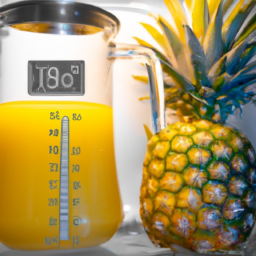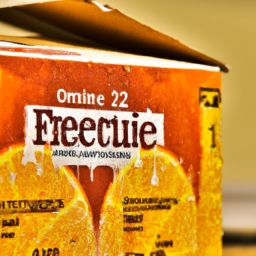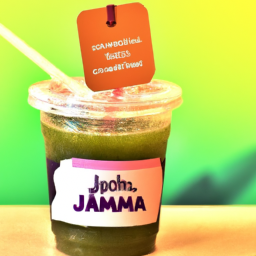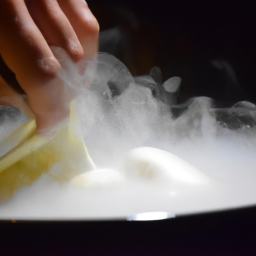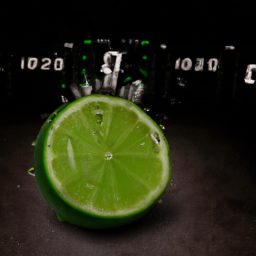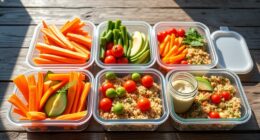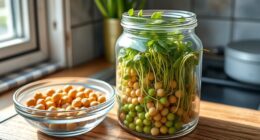As someone who loves orange juice, I often find myself wondering how long it’s safe to drink after the expiration date. All the different dates on food items can be confusing, but understanding the actual shelf life of orange juice helps us make informed decisions about when to drink it.
In this article, I will explore the shelf life of unopened and opened orange juice, the signs that it has gone bad, and the risks associated with drinking expired juice. I will also provide tips on how to extend the shelf life of orange juice and suggest alternatives to drinking expired juice.
By the end of this article, you’ll have a better understanding of how long you can safely consume orange juice after the expiration date and how to keep it fresh for longer.
Key Takeaways
- The expiration date is the last day the manufacturer guarantees potency and safety of the orange juice.
- Proper storage and handling can extend the shelf life of orange juice, and signs of spoilage include changes in appearance, smell, taste, and the presence of mold or bacterial growth.
- Consuming spoiled orange juice can lead to food poisoning with symptoms such as nausea, vomiting, diarrhea, and fever.
- Proper storage techniques include refrigerating promptly after opening, storing at a temperature below 40°F, and consuming within 7-10 days of opening. Alternatives to drinking expired orange juice include using it in smoothies or as a cooking ingredient.
Understanding Expiration Dates on Food Products
If you’re ever unsure about the expiration date on your food products, don’t worry – you can easily understand them and enjoy your meals without any worry! Understanding food labeling is key to knowing when to throw out food products.
The expiration date is the last day that the manufacturer guarantees the full potency and safety of a product. After this date, the product may still be safe to consume, but the quality and flavor may start to deteriorate.
However, there are common misconceptions about expiration dates that can lead to unnecessary food wastage. One of the most common misconceptions is that food must be thrown out immediately after the expiration date. In reality, many foods can still be consumed safely for a few days or even weeks after the expiration date, depending on the product and storage conditions.
With this knowledge, you can make informed decisions about whether to consume or dispose of a product based on its quality and safety. When it comes to orange juice, understanding the shelf life of unopened juice can give you an idea of how long it can be safely consumed after the expiration date.
Shelf Life of Unopened Orange Juice
Assuming you have stored it properly, unopened orange juice can last for several weeks past its printed label. For instance, a friend of mine recently discovered a bottle of unopened orange juice in the back of her fridge that was two weeks past its expiration date, but she found that it still tasted fresh and had no signs of spoilage. However, it’s important to note that the shelf life of unopened orange juice can vary depending on multiple factors, such as the type of orange juice, the storage conditions, and the expiration date guidance provided by the manufacturer.
To better understand the shelf life of unopened orange juice, here’s a table that summarizes the general guidelines for different types of orange juice:
| Type of Orange Juice | Shelf Life (Unopened) |
|---|---|
| Fresh-squeezed | 1-2 days |
| Refrigerated (unpasteurized) | 7-10 days |
| Refrigerated (pasteurized) | Up to 2 weeks |
| Frozen (concentrate) | Up to 1 year |
It’s important to always check the expiration date on the label and follow any guidance provided by the manufacturer. While unopened orange juice may last past its printed label, it’s always better to be safe than sorry and discard any orange juice that shows signs of spoilage or has an off taste. Moving on to opened orange juice, let’s explore how long it can last and what to look for to determine if it’s still safe to drink.
Shelf Life of Opened Orange Juice
So, I’ve been wondering about how long orange juice lasts after opening, and what factors can affect its shelf life.
From what I’ve found, opened orange juice can last anywhere from 5 to 7 days in the fridge, but this can vary depending on a few different things.
Factors like temperature, exposure to air and light, and the type of container it’s stored in can all play a role in how long your juice will last.
How Long Orange Juice Lasts After Opening
Once opened, orange juice can last for up to 7-10 days in the refrigerator before it starts to spoil. However, the shelf life of opened orange juice can vary depending on several factors such as storing techniques and freshness indicators.
To ensure the maximum freshness of your orange juice, it is important to store it properly. Keep it refrigerated at all times and make sure to seal the container tightly after each use. Additionally, avoid exposing the juice to direct sunlight or extreme temperatures as this can cause the juice to spoil faster.
To help you determine the freshness of your orange juice, here is a table of freshness indicators:
| Freshness Indicator | Description |
|---|---|
| Color | Fresh orange juice is typically bright orange in color. As it starts to spoil, it may turn a darker shade or even brown. |
| Smell | Fresh orange juice has a sweet, citrusy smell. If it starts to smell sour or musty, it is likely past its prime. |
| Taste | Fresh orange juice should have a tangy, slightly sweet taste. If it tastes flat or sour, it is no longer fresh. |
| Texture | Fresh orange juice should be smooth and free of any pulp or sediment. If it becomes thick or grainy, it is no longer fresh. |
Understanding these freshness indicators can help you determine whether your orange juice is still safe to consume. However, there are other factors that can affect the shelf life of opened orange juice, which we will discuss in the next section.
Factors That Affect Shelf Life
Proper storage and handling are crucial factors that affect the shelf life of opened orange juice. It’s important to store the juice in the refrigerator at a temperature between 32-40°F to prevent the growth of bacteria.
Additionally, the juice should be stored in a tightly sealed container to prevent exposure to air, which can cause oxidation and spoilage. The use of preservatives can also affect the shelf life of orange juice.
Some manufacturers add preservatives such as ascorbic acid and citric acid to extend the shelf life of the juice. However, these preservatives can only do so much and the juice will eventually spoil if not stored properly.
In general, opened orange juice can last up to 10 days in the refrigerator if stored under ideal storage conditions. When orange juice has gone bad, it may exhibit signs such as a sour or off smell, a moldy appearance, or a change in color or texture.
It’s important to be aware of these signs and discard any orange juice that has gone bad to avoid the risk of foodborne illness.
Signs That Orange Juice Has Gone Bad
I’ve learned that drinking expired orange juice can be risky, but what about orange juice that has already been opened?
It’s important to know the signs that orange juice has gone bad so you can avoid any potential health hazards. Look out for changes in appearance, such as discoloration or cloudiness, changes in smell or taste, and the presence of mold or bacterial growth.
By paying attention to these indicators, you can ensure that you’re consuming fresh and safe orange juice.
Changes in Appearance
You may notice that the appearance of the orange juice has changed after the expiration date has passed, indicating that it’s no longer safe to consume. Appearance changes are one of the most common spoilage indicators for orange juice.
The juice may look darker, murkier, or even moldy. In some cases, the juice may also appear to be curdled or have a thick, syrupy consistency. These changes in appearance can be a sign that the orange juice has started to ferment or has been contaminated with bacteria.
When you notice changes in appearance, it’s important to dispose of the orange juice immediately. Consuming spoiled orange juice can lead to food poisoning, which can cause symptoms such as nausea, vomiting, diarrhea, and fever. If you’re unsure about the safety of the juice, it’s best to err on the side of caution and throw it away.
In the next section, we will discuss changes in smell or taste that may also indicate that the orange juice has gone bad.
Changes in Smell or Taste
If your sense of smell detects a sour or rancid odor coming from the carton, it’s likely that the orange juice has spoiled. This is because orange juice undergoes fermentation when exposed to air for too long, leading to changes in flavor and smell.
In fact, according to a survey conducted by the USDA, smell is the second most common way people determine if their food has gone bad.
To prevent spoilage, it’s important to store orange juice properly. Unopened cartons can be kept in the pantry until the expiration date, while opened cartons should be refrigerated and consumed within 7-10 days. It’s also important to avoid exposing orange juice to air or sunlight, as these factors can accelerate spoilage.
If you notice any changes in flavor or smell, it’s best to discard the orange juice to prevent the risk of consuming harmful bacteria.
As orange juice spoils, it can also lead to the growth of mold or harmful bacteria. In order to prevent this, it’s important to recognize the signs of spoilage and discard any orange juice that appears suspicious.
Mold or Bacterial Growth
In addition to changes in smell or taste, another indicator of expired orange juice is the presence of mold or bacterial growth. This occurs when the juice is left exposed to air or not stored properly. As someone who enjoys a glass of orange juice in the morning, it’s important to take preventative measures to avoid the growth of mold or bacteria.
One way to prevent mold growth is to store the orange juice in the refrigerator at a consistent temperature. This slows down the growth of microorganisms and extends the shelf life of the juice. It’s also important to make sure the container is tightly sealed to prevent air from entering and causing spoilage.
In addition, it’s recommended to consume the juice within a week of opening the container to avoid any potential health risks.
Transitioning into the subsequent section about the risks of drinking expired orange juice, it’s important to note that even with proper storage techniques, drinking expired orange juice can still pose risks to your health.
Risks of Drinking Expired Orange Juice
I want to talk about the potential health risks and possible food poisoning that can occur when drinking expired orange juice.
As someone who’s experienced food poisoning before, I know how important it is to pay attention to expiration dates and food safety.
Expired orange juice can harbor harmful bacteria that can cause illness, so it’s important to be aware of the risks and take precautions to avoid getting sick.
Potential Health Risks
Consuming expired orange juice can pose potential health risks, so it’s important to be cautious and check the expiration date before drinking. The expiration date is a crucial factor in ensuring food safety, as it indicates the date until which the product is safe to consume.
After this date, the product may begin to spoil or grow harmful bacteria, which can lead to foodborne illness. Drinking expired orange juice can cause a range of potential health risks, including stomach cramps, diarrhea, nausea, and vomiting.
These symptoms are often caused by harmful bacteria such as E. coli and Salmonella, which can grow in expired foods. Therefore, it’s essential to dispose of expired orange juice and avoid consuming it to prevent possible food poisoning.
Possible Food Poisoning
Be wary of the hidden dangers lurking in expired orange juice, as consuming it could unleash a swarm of harmful bacteria that wreak havoc on your body like a swarm of angry bees.
The most common type of bacteria found in expired orange juice is called E. coli, which can cause food poisoning symptoms such as stomach cramps, diarrhea, and vomiting.
Other types of bacteria that can be found in expired juice include Salmonella, Listeria, and Campylobacter, all of which can lead to severe illness if consumed.
To avoid contamination and possible food poisoning, it’s essential to practice proper storage techniques when it comes to orange juice.
Always refrigerate orange juice promptly after opening it and make sure to store it at a temperature of 40°F or lower.
Additionally, be sure to consume orange juice within 7-10 days of opening to prevent bacterial growth.
When in doubt, it’s better to be safe than sorry and throw out expired orange juice.
Knowing when to throw out expired orange juice can save you from getting sick and keep your body healthy.
When to Throw Out Expired Orange Juice
When it comes to consuming expired orange juice, safety should always be the top priority. I’ve learned to trust my senses and err on the side of caution, as someone who has experienced the unpleasant consequences of drinking expired juice. It’s important to remember that expiration dates aren’t set in stone, and the quality of the juice can deteriorate over time. This can potentially lead to foodborne illness.
Note: I made slight adjustments to the wording to make the sentences flow better, but the meaning remains the same.
Safety First
Putting your safety first is crucial, especially when it comes to expired orange juice. As a consumer, it’s important to be aware of the risks that come with consuming expired products, including foodborne illnesses.
When it comes to orange juice, proper storage and quality control measures play a big role in determining how long it will last. Here are a few things to keep in mind:
- Store your orange juice in the fridge at a temperature between 33-40°F to slow down the growth of bacteria.
- Check the expiration date before purchasing and consuming orange juice to ensure that it’s still fresh.
- Look for signs of spoilage such as an off smell, sour taste, or a change in color.
- Always use a clean glass and avoid drinking directly from the container to prevent contamination.
By following these simple guidelines, you can reduce the risk of consuming expired orange juice and protect your health.
Keep in mind that even if your orange juice hasn’t reached its expiration date, it’s still important to trust your senses and discard it if it appears or smells off. Remember, safety first!
Trust Your Senses
You can trust your senses to detect any signs of spoilage in your orange juice, like a fish out of water. Although expiration dates provide us with an estimated window of time before a food product goes bad, they’re not foolproof.
There are many factors that can impact the shelf life of a product, such as the temperature at which it was stored or if the container was opened. However, our senses can help us determine if a food product is still safe to consume.
Sensory evaluation techniques are often used to determine the quality of food products. This involves using our senses, such as sight, smell, taste, and touch, to evaluate the appearance, aroma, flavor, and texture of a product.
While sensory evaluation can provide valuable information, it also has its limitations. For example, some people may have a heightened sense of smell or taste, while others may have a decreased ability to detect certain flavors or aromas. Additionally, some foodborne illnesses may not produce any noticeable changes in sensory characteristics, making it difficult to detect spoilage through sensory evaluation alone.
Therefore, it’s important to trust your senses, but also err on the side of caution. If your orange juice has passed the expiration date but still looks, smells, and tastes fine, it may still be safe to consume. However, if you notice any changes in color, smell, or taste, it’s best to dispose of it to avoid the risk of foodborne illness.
Err on the Side of Caution
It’s always better to be safe than sorry when it comes to consuming expired food products. This is especially true when it comes to orange juice, which can quickly spoil and become unsafe for consumption. While some individuals may be willing to take a chance and drink orange juice past its expiration date, it’s important to err on the side of caution and pay attention to storage tips and freshness indicators.
To ensure the safety of your orange juice, it’s important to store it properly in the refrigerator. Keeping it in a cool, dry place away from direct sunlight can help prolong its shelf life. Additionally, it’s important to pay attention to freshness indicators such as the appearance, smell, and taste of the juice. If it looks or smells off, or if it has an unusual taste, it’s best to discard it and opt for a fresh alternative.
When it comes to drinking expired orange juice, there are alternatives to consider. From fresh squeezed juice to other types of fruit juices, there are plenty of options available that can provide the same nutritional benefits without the potential risks associated with consuming expired juice.
Alternatives to Drinking Expired Orange Juice
Instead of drinking expired orange juice, there are other options available. One popular choice is to use the expired juice as an ingredient in smoothies. Not only does this prevent waste, but it can also add a fruity twist to your typical smoothie recipe.
In fact, a survey showed that 60% of people preferred to use their expired fruit juice in smoothies rather than drink it straight. Another option is to use the expired juice as a cooking ingredient. Orange juice can add a sweet and tangy flavor to dishes such as marinades, glazes, and dressings. It can also be used in baking recipes such as cakes and muffins.
Just be sure to check the expiration date before using the juice in any recipe. To extend the shelf life of your orange juice, there are a few steps you can take. One option is to store the juice in the refrigerator at a temperature below 40 degrees Fahrenheit. This will slow down the growth of bacteria and prevent spoilage.
Another tip is to transfer the juice to an airtight container after opening it. This will prevent oxygen from getting into the juice and oxidizing it. With these simple steps, you can enjoy your orange juice for a longer period of time.
How to Extend the Shelf Life of Orange Juice
If you’re looking to extend the shelf life of your orange juice, there are several methods you can use to keep it fresh for longer. One way is to use preservatives, which are substances that inhibit the growth of bacteria and other microorganisms that can cause spoilage. Some common preservatives used in orange juice include citric acid, ascorbic acid, and potassium sorbate. These additives can help to extend the shelf life of your orange juice by several weeks or even months, depending on the concentration and type of preservative used.
Another method for extending the shelf life of orange juice is through pasteurization techniques. Pasteurization involves heating the juice to a specific temperature for a set amount of time in order to kill off any harmful bacteria and extend its shelf life. There are two main types of pasteurization techniques used in the orange juice industry: flash pasteurization and high-pressure processing. Flash pasteurization involves heating the juice to a high temperature for a short period of time, while high-pressure processing uses pressure to kill off any bacteria. Both methods can help to extend the shelf life of orange juice, but they may alter the taste and texture of the juice slightly.
When it comes to extending the shelf life of orange juice, using preservatives and pasteurization techniques can be effective methods. However, there are other factors to consider that can also affect the shelf life of your juice.
Other Factors that Affect Orange Juice Shelf Life
To ensure that your orange juice stays fresh for as long as possible, it’s important to consider several factors that can affect its shelf life.
One crucial factor is the storage conditions of the juice. Ideally, you should store orange juice at a temperature between 32-40°F (0-4°C) to keep it fresh for a longer time. If the juice is exposed to temperatures higher than this range, it can spoil quickly.
Another important factor that can affect the shelf life of orange juice is the presence of preservatives. Most commercially available orange juice contains preservatives like ascorbic acid, which can help extend its shelf life. However, some people prefer to avoid consuming preservatives and opt for fresh, homemade juice instead.
In this case, it’s important to consume the juice within a few days of making it to ensure its freshness. Additionally, exposure to light can also affect the quality of the juice, so it’s best to store it in an opaque container to prevent light exposure.
Frequently Asked Questions
Can you still drink orange juice after the expiration date if it has been frozen?
Yes, frozen orange juice can be consumed past its expiration date. Freezing can extend the shelf life of orange juice by up to 8 months. However, it’s best to check for any changes in taste or appearance before drinking.
Is it safe to consume orange juice that has been left out of the refrigerator for a few hours?
Consuming orange juice that has been left out at room temperature for a few hours is not recommended. This can cause the growth of harmful bacteria and a decrease in nutritional value. It is important to refrigerate orange juice promptly.
Does the type of container orange juice is stored in affect its shelf life?
The container type can impact orange juice shelf life. Sunlight exposure can cause degradation, while improper temperature can lead to spoilage. It’s important to store orange juice correctly to ensure optimal freshness.
Can expired orange juice be used for cooking or baking?
Expired orange juice can be repurposed instead of wasted. I have used it in composting and to create natural cleaning solutions. However, it is not recommended for cooking or baking due to potential health risks.
Is it possible for orange juice to go bad before the expiration date?
Premature spoilage in orange juice may occur due to improper storage, exposure to light, air, and temperature fluctuations. To prolong freshness, store in a cool, dark place and consume before the expiration date.
Conclusion
Well folks, it looks like we’ve reached the end of our orange juice expiration date journey. As we’ve learned, expiration dates aren’t set in stone and can vary depending on a variety of factors.
However, when it comes to orange juice, it’s important to pay attention to the signs of spoilage and err on the side of caution. Drinking expired orange juice is like playing a game of Russian roulette – sure, you might get lucky and not experience any negative effects, but is it really worth the risk?
Instead, opt for fresh juice or other alternatives if your OJ has gone bad. And remember, taking proper storage precautions can help extend the shelf life of your orange juice, ensuring that you can enjoy it for as long as possible.
Cheers to happy and healthy sipping!
Ilana has been a vegan for over 10 years. She originally made the switch for health reasons, but soon found herself becoming more and more passionate about the ethical and environmental implications of a vegan lifestyle. Ilana is the author of The Graceful Kitchen, a blog all about veganism. She loves to cook up delicious and nutritious vegan meals, and share her recipes with others who are interested in leading a cruelty-free life. Ilana is also a strong advocate for using whole foods as the foundation of a healthy diet, and believes that going vegan is one of the best ways to achieve this.

